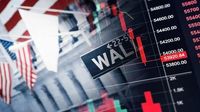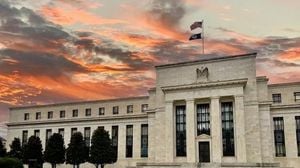U.S. stock markets kicked off the week of August 11, 2025, with a blend of optimism and caution, as investors digested record-breaking performances, new trade policies, and the looming release of critical inflation data. Following a robust showing the previous week—where the Nasdaq Composite notched back-to-back records and the S&P 500 flirted with all-time highs—Monday saw futures for major indices rise again, signaling continued bullishness tempered by uncertainty.
The Nasdaq Composite, in particular, continued its impressive run, reaching a fresh 52-week high of 21,549.73 during Monday’s session, according to Goodreturns.in. As of 12:17 PM Eastern, the index was up 0.42% for the day at 21,540.17. The S&P 500, meanwhile, hovered at 6,401.68, just shy of its own 52-week high of 6,427.02, while the Dow Jones Industrial Average experienced a slight dip, trading at 44,152.42—down 0.052% on the day, but still within striking distance of its yearly peak of 45,073.63.
These gains followed a week in which the Dow climbed 1.4%, the S&P 500 added 2.4%, and the Nasdaq surged 3.9%. Apple Inc. led the charge among technology giants, rising 4.2% on Friday and posting a weekly gain exceeding 12%, its best performance since August 2020, as reported by Benzinga. However, not all companies shared in the euphoria: Under Armour, Inc. tumbled 18% after its first-quarter fiscal 2026 results missed Wall Street expectations, and The Trade Desk Inc. saw its stock plummet over 38% following its second-quarter earnings report.
Market sentiment has been shaped in part by President Donald Trump’s new "reciprocal tariffs," which took effect the week prior. The surprise imposition of import tariffs on gold bars, for example, is expected to put pressure on Switzerland’s refining industry. These tariffs are just one of several trade tensions investors are watching closely, as highlighted by Ajay Kedia of Kedia Advisory, who noted, "While geopolitical risk has softened, lingering trade tensions and expectations of Federal Reserve rate cuts are helping cap losses."
Adding to the mix, President Trump announced his intention to nominate Stephen Miran, the White House’s top economist, to a short-term seat on the Federal Reserve’s Board of Governors. This move comes as markets price in a high probability of monetary easing: both Benzinga and Goodreturns.in report that traders see an 87–88% chance of a Fed rate cut at the September 17, 2025, meeting, based on CME Group’s FedWatch tool.
But the optimism isn’t universal. Investors are on edge as they await the release of key economic indicators—especially the Consumer Price Index (CPI) and Producer Price Index (PPI), scheduled for Tuesday and Thursday, respectively. These reports are expected to heavily influence the Federal Reserve’s next move on interest rates, particularly ahead of the central bank’s annual Jackson Hole meeting later in August.
Sam Stovall, Chief Investment Strategist at CFRA Research, voiced a note of caution to CNBC: "I'm getting a little concerned that the market is going to end up being disappointed. If inflation remains sticky and consumer spending stays strong, the Fed may not see a reason to cut rates." This sentiment was echoed by Ed Yardeni of Yardeni Research, who observed, "The odds are low that we'll see downside surprises in July CPI inflation data. There's little doubt that tariff effects are boosting durable goods inflation, as they did in June. But the risk of a big upward surprise is tempered by signs that rents and used car prices are cooling." Yardeni cited the Cleveland Fed's Inflation Nowcasting model, which projects the CPI to rise 3.04% in July and 3.02% in August—figures he called "too hot to justify Fed easing."
Meanwhile, the broader economic landscape is being shaped by a host of other factors. The yield on the 10-year Treasury bond stood at 4.26%, while the two-year bond yielded 3.75%. The futures market reflected cautious optimism: Dow Jones futures rose 0.27%, S&P 500 futures 0.17%, Nasdaq 100 futures 0.13%, and Russell 2000 futures 0.31% as trading began Monday.
Investors are also preparing for a busy week of earnings reports from major companies such as Cisco Systems Inc., CoreWeave Inc., and Circle Internet Group Inc. In addition, several high-profile corporate moves made headlines: Nvidia Corp. dropped 1.23% and Advanced Micro Devices Inc. fell 2.44% after agreeing to pay 15% of their revenue from AI chip sales in China to the U.S. government. Western Union rose 1.37% on news it would acquire Intermex for about $500 million in cash. Nyxoah SA surged 19.41% after receiving FDA approval for its Genio system to treat obstructive sleep apnea, and Enphase Energy climbed 3.24% after launching its 4th-generation energy system and securing approval from San Diego Gas & Electric.
Commodities painted a mixed picture: crude oil futures slipped 0.52% to around $63.55 per barrel, while gold spot prices fell 0.97% to $3,365.67 per ounce. Asian stock markets mostly rose on Friday, with the exception of South Korea’s Kospi index, while European markets were largely lower in early trade on Monday.
Looking ahead, investors are bracing for a slew of economic data releases. Tuesday will see the NFIB optimism index and the all-important CPI report for July. Later in the week, the Producer Price Index, retail sales, industrial production, and consumer sentiment data will provide further clues about the health of the U.S. economy and the likely direction of Fed policy.
As Mohamed El-Erian, a senior economist, pointed out, it remains too soon to determine the full impact of America’s new tariff regime. "To date, many companies appear to have utilized existing inventories, absorbed costs through profit margins, and exerted pressure on foreign suppliers as temporary buffers, awaiting a clearer picture of the tariff regime (content and durability)," he explained. He warned that both domestic and foreign firms now face tough decisions regarding pricing, supply chains, and market focus, with outcomes likely to vary widely across sectors.
In sum, while Wall Street continues to ride a wave of record highs and strong corporate earnings, the path forward is anything but certain. With inflation data, Fed policy, and global trade dynamics all in flux, investors are keenly aware that the coming weeks could prove pivotal for markets—and for the broader U.S. economy.





